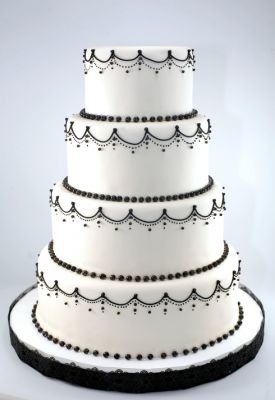 While some couples opt for cupcake towers, donuts, croquembouches and other tasty goodies, the classic multitiered cake remains popular at many weddings. As you’re pondering possibilities for your own event, you might find the array of options for dressing your own cake overwhelming and somewhat confusing. If you don’t know the difference between buttercream and fondant icing, or how to tell gum paste and modeling chocolate apart, here’s some information you might find useful as you’re picking out the extras for your delicious confection.
While some couples opt for cupcake towers, donuts, croquembouches and other tasty goodies, the classic multitiered cake remains popular at many weddings. As you’re pondering possibilities for your own event, you might find the array of options for dressing your own cake overwhelming and somewhat confusing. If you don’t know the difference between buttercream and fondant icing, or how to tell gum paste and modeling chocolate apart, here’s some information you might find useful as you’re picking out the extras for your delicious confection.
The Low-Down on Fondant Icing
While browsing wedding cake designs on Pinterest, Instagram or in other places, you’ve probably seen exquisite towers of meticulously executed artistic designs. One major secret behind the height-defying acrobatics on these sweet treats is fondant icing. Brides contributor Sandy Malone describes the substance as having a consistency like “rolled-out marshmallows," as it's somewhat chewy and stiff in its final form. Simply put, its composition is water and sugar that’s been cooked and beaten smooth. In some cases, additional flavoring elements are incorporated in a fondant mix before it’s rolled out and placed on a cake.
Malone observes that the fondant icing on a wedding cake is often left uneaten while the inner layers and filling are devoured instead. She cites multiple reasons for this tendency among guests:
- Fondant is excessively sweet
- The cake might look “too pretty to eat”
- It can be difficult to chew
Buttercream: A Softer, Simpler Frosting
Remember the cakes you’ve eaten at birthday parties, showers or other celebrations? Chances are that many of them had buttercream frosting. It’s not a top choice with couples who want desserts with intricate exteriors, but it is a great option for those eyeing a simpler design and more flavor. It’s typically made from combining powdered sugar with butter, milk and vanilla extract. Additional elements such as cocoa, orange or lemon zest and juice, lavender oil or espresso can be added to produce unique icings. Malone adds that pairs desiring both taste and artistic design can incorporate a thick layer of buttercream underneath a topcoat of fondant. With even the outside shell of decorative icing gone, the buttercream is left behind for attendees to enjoy.
Molding the Sugary Add-Ons
Outer details and toppers crafted from fondant remain in high demand. However, some decorators keep other options such as modeling chocolate and gum paste in their decorative toolboxes. Jessica Oleson Moore published an informative write-up explaining the properties of and differences between these three materials on the Craftsy blog. Gum paste is a specialized pliable dough fabricated from egg whites, confectioners’ sugar and shortening. Many recipes include tylose powder, a confectionary glue that helps it harden and stick. Meanwhile, modeling chocolate is made from melting and combining chocolate with either corn syrup or simple syrup, and then kneading the mixture until it’s stiff enough to shape.
Modeling chocolate and gum paste are usually reserved for embellishing details. Gum paste is the least palatable of the three, with some describing the taste similar to “sugary crackers.” In contrast, modeling chocolate is both delicious and versatile. It’s not generally used for coating an entire cake due to the high cost of its production, but it’s an excellent choice for decorative touches and figurines. The only drawback is that it melts quite easily, especially when exposed for long periods of time to the hot sun.
Choosing Your Wedding Day’s Special Treats
It’s a good idea to know some of the basics behind the frosting and external embellishments that might end up on your cake. Fondant, buttercream icing, modeling chocolate and gum paste can all play important roles in supplying looks and flavor. Your end goals, whether it’s to present an edible show-stopping focal point or a down-to-earth dessert, should impact your final choices.
Add Your Comment